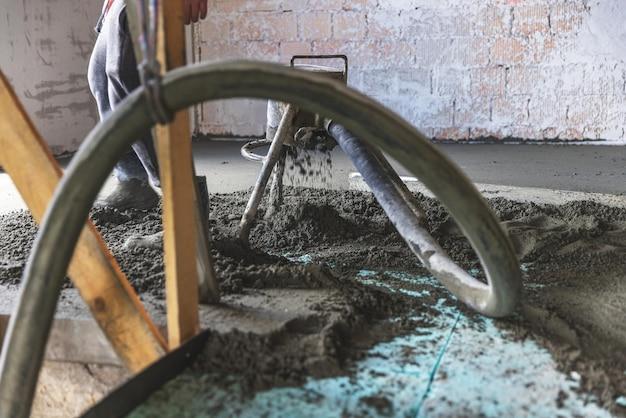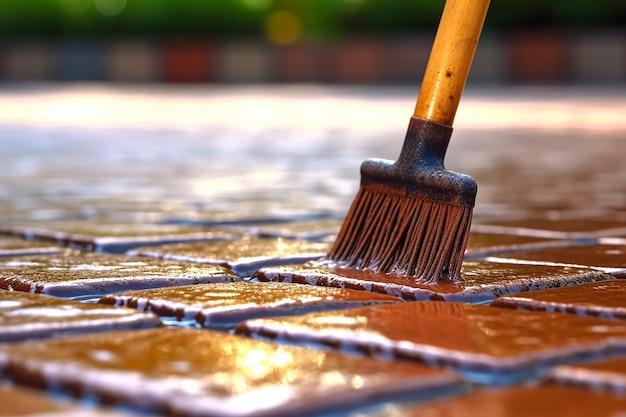Welcome to our blog post on the topic of using Quikrete in different temperatures. Whether you’re a DIY enthusiast or a professional contractor, understanding the ideal temperature conditions for working with Quikrete is crucial for successful concrete projects. In this article, we will answer common questions like “Can you do cement work in cold weather?” and “What happens if you add too much water to Quikrete?” We will also explore the effects of low temperatures on concrete curing and provide helpful tips for working with Quikrete in chilly conditions.
When it comes to using Quikrete, the weather can be a significant factor in achieving optimal results. With temperatures dropping below freezing in some regions, it’s important to know the minimum temperature requirements for working with Quikrete. Join us as we delve into the science of concrete curing, discuss the impact of cold weather on the process, and share expert advice to help you navigate cold-weather concreting challenges successfully.
So, if you’re curious about whether concrete can cure at 40 degrees or looking for tips on how to pour concrete in cold weather, you’ve come to the right place. Let’s dive in and discover how to achieve outstanding results with Quikrete, no matter the temperature outside.
How Warm Does It Have To Be To Use Quikrete
Using Quikrete for your home improvement projects can be a game-changer. But what if the weather is not on your side? How warm does it have to be to use Quikrete? Let’s find out!
Ideal Temperature for Quikrete
When it comes to Quikrete, temperature matters. The ideal temperature range for using Quikrete is between 50°F and 90°F (10°C and 32°C). Within this range, Quikrete sets properly, gains strength, and cures effectively. However, keep in mind that these are just general guidelines, and there may be specific variations depending on the type of Quikrete product you’re using.
Below 50°F: Chill Out!
Using Quikrete when it’s too cold can lead to slower setting and curing times. If the temperature drops below 50°F (10°C), it’s best to hold off on your Quikrete project. Cold weather hampers the hydration process, making it difficult for Quikrete to achieve its intended strength. So, grab a cup of hot cocoa, cozy up by the fireplace, and save your Quikrete dreams for a warmer day.
Above 90°F: Hot Stuff!
On the flip side, extremely hot weather can also cause challenges for your Quikrete project. When temperatures soar above 90°F (32°C), Quikrete can dry out too quickly, resulting in improper curing. This can weaken the final structure and affect its durability. So, if the mercury is climbing, it’s best to postpone your Quikrete endeavors until it cools down a bit. Don’t let the blazing sun scorch your plans!
Why Temperature Matters
You might be wondering, why is temperature so crucial when working with Quikrete? Well, let’s break it down. Quikrete is a mixture of cement, sand, and other additives. When water is added, a chemical reaction called hydration occurs, which is essential for the mixture to harden and gain strength. Temperature plays a vital role in the speed and effectiveness of this reaction. So, it’s important to find the Goldilocks zone to get the best results.
A Case of Cold Feet
If you’re tempted to try your luck with Quikrete in cold weather, think again! Cold temperatures can lead to a sluggish hydration process, meaning your Quikrete won’t cure properly. If you rush into using Quikrete when it’s too cold, you may find yourself with weak and brittle results. Don’t let your impatience freeze your dreams of a sturdy structure. Waiting for warmer weather will ensure your Quikrete project is a success.
No Need to Break a Sweat
Likewise, scorching temperatures can spell trouble for your Quikrete adventure. Working with Quikrete in excessively hot weather means the mixture can dry out too fast, preventing proper curing. You don’t want all your hard work to crumble under the sweltering heat. So, take a breather, enjoy some shade, and wait for the temperature to cool down. Your Quikrete project will thank you!
Mother Nature’s Influence
While the ideal temperature range for using Quikrete is between 50°F and 90°F (10°C and 32°C), it’s important to consider other factors too. Humidity, wind, and sunlight exposure can all affect the curing process. High humidity can slow down the drying time, while wind and direct sunlight can speed it up. So, be sure to factor in Mother Nature’s unique touch when planning your Quikrete project.
So, now you know the ideal temperature range for using Quikrete. Remember, too cold or too hot is not the way to go. Wait for that sweet spot between 50°F and 90°F (10°C and 32°C), and you’ll be well on your way to Quikrete success. Cheers to a sturdy and reliable home improvement project!
FAQ: How Warm Does It Have To Be To Use Quikrete
Can you do cement work in cold weather?
Yes, you can definitely do cement work in cold weather. However, it’s important to understand the impact of temperature on the curing process.
Will concrete cure at 40 degrees?
Concrete does have the ability to cure at 40 degrees Fahrenheit, but the process will be significantly slower. As the temperature drops, so does the rate of concrete curing.
What happens if you add too much water to Quikrete?
Adding too much water to Quikrete can result in a weaker final product. This excess water dilutes the mixture, leading to decreased strength and durability. So, it’s always essential to follow the recommended water-to-mix ratio.
How cold is too cold for Quikrete?
While Quikrete is designed to withstand low temperatures, it’s generally not recommended to use it below 40 degrees Fahrenheit. At extremely cold temperatures, the curing process can be significantly delayed or even hindered.
Will concrete cure below 50 degrees?
Yes, concrete can cure below 50 degrees Fahrenheit. However, the time it takes for the concrete to cure will be longer compared to warmer temperatures. Patience is key when working with concrete in colder conditions.
Do let new concrete get too cold? True or false?
False. Don’t let new concrete get too cold! Extreme cold can negatively affect the curing process and compromise the quality of the final result. Protecting newly poured concrete from freezing temperatures is essential for optimal curing and strength development.
What is the maximum temperature concrete can withstand?
Concrete can withstand high temperatures, but it’s crucial to avoid rapid temperature changes. Sudden exposure to extreme heat can cause thermal cracking. Generally, concrete can withstand temperatures up to 300 degrees Fahrenheit without significant damage.
Which cement should be used in cold weather concreting?
For cold weather concreting, it’s best to use a cement mix specifically designed for such conditions. Opt for products with added accelerators that help speed up the curing process and enhance strength development even in colder temperatures.
How long should concrete be covered?
Concrete should be covered for a period of at least 3 to 7 days after pouring. This protective cover helps to retain moisture, regulate temperature, and promote proper curing. Keep in mind that colder temperatures might require longer covering durations.
What temperature does concrete stop curing?
Concrete doesn’t exactly “stop” curing at a specific temperature, but its curing process significantly slows down as temperatures drop below 40 degrees Fahrenheit. Colder temperatures lengthen the time required for concrete to reach its full strength potential.
What time of year is best to pour concrete?
The best time of year to pour concrete is during moderate temperatures, typically in spring or fall. These seasons offer a balance of temperature, avoiding the extreme heat of summer and the bitter cold of winter. However, with proper precautions, concrete can be poured in any season.
At what temperature does concrete freeze?
Concrete begins to freeze once the temperature drops below 32 degrees Fahrenheit (0 degrees Celsius). To prevent freezing, it’s crucial to protect the newly poured concrete from exposure to freezing temperatures during the initial curing phase.
Can you use Quikrete in the cold?
Yes, you can use Quikrete in cold weather conditions. However, it’s important to closely follow the instructions provided by the manufacturer. Additionally, consider using accelerators or other additives specifically designed to aid curing in lower temperatures.
Will concrete cure at 35 degrees?
Concrete can still cure at 35 degrees Fahrenheit, but the curing process will be significantly slower. It’s vital to provide ample time for proper curing and to protect the concrete from freezing during this period.
Will concrete cure at 30 degrees?
Concrete can cure at 30 degrees Fahrenheit, but it will take even longer compared to higher temperatures. The lower the temperature, the slower the curing process becomes. Patience and proper insulation are key when working with concrete in such cold conditions.
What if it rains after pouring concrete?
If it starts raining shortly after pouring concrete, it can negatively impact the curing process. Rainwater can wash away the cement paste and weaken the overall structure. Protect the fresh concrete from rain by covering it with plastic sheets or using temporary shelters.
What is the maximum temperature to pour concrete?
When it comes to pouring concrete, it’s wise to avoid extreme heat. A maximum temperature of around 90 degrees Fahrenheit is generally recommended. High temperatures can lead to faster moisture evaporation, which affects the curing process and ultimately weakens the concrete.
Should you cover concrete with plastic in cold weather?
Yes, covering concrete with plastic in cold weather is a good practice. The plastic acts as a barrier, retaining moisture and heat, which aids in the curing process. However, ensure proper ventilation to prevent condensation buildup and potential water-related issues.
How long does concrete take to cure at 40 degrees?
Concrete typically takes around 7 to 14 days to cure at 40 degrees Fahrenheit. However, please note that curing times can vary depending on factors such as mix design, thickness, and ambient humidity. Monitor the concrete’s strength development before proceeding with any significant load-bearing activities.
Now that you have answers to frequently asked questions about using Quikrete in various temperatures, you’re prepared to tackle your concrete projects with confidence, no matter the weather. Remember to be patient, follow the instructions, and take the necessary precautions to achieve the best results. Happy concreting!

